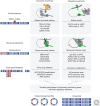Chromatin Mechanisms Driving Cancer
- PMID: 34187809
- PMCID: PMC8886982
- DOI: 10.1101/cshperspect.a040956
Chromatin Mechanisms Driving Cancer
Abstract
The change in cell state from normal to malignant is driven fundamentally by oncogenic mutations in cooperation with epigenetic alterations of chromatin. These alterations in chromatin can be a consequence of environmental stressors or germline and/or somatic mutations that directly alter the structure of chromatin machinery proteins, their levels, or their regulatory function. These changes can result in an inability of the cell to differentiate along a predefined lineage path, or drive a hyperactive, highly proliferative state with addiction to high levels of transcriptional output. We discuss how these genetic alterations hijack the chromatin machinery for the oncogenic process to reveal unique vulnerabilities and novel targets for cancer therapy.
Copyright © 2022 Cold Spring Harbor Laboratory Press; all rights reserved.
Figures




References
-
- Agaram NP, LaQuaglia MP, Alaggio R, Zhang L, Fujisawa Y, Ladanyi M, Wexler LH, Antonescu CR. 2019. MYOD1-mutant spindle cell and sclerosing rhabdomyosarcoma: an aggressive subtype irrespective of age. A reappraisal for molecular classification and risk stratification. Mod Pathol 32: 27–36. 10.1038/s41379-018-0120-9 - DOI - PMC - PubMed
-
- Aplan PD, Shern JF, Khan J. 2021. Molecular and genetic basis of childhood cancer. Kluwer, Amsterdam.
Publication types
MeSH terms
Substances
LinkOut - more resources
Full Text Sources
Medical
